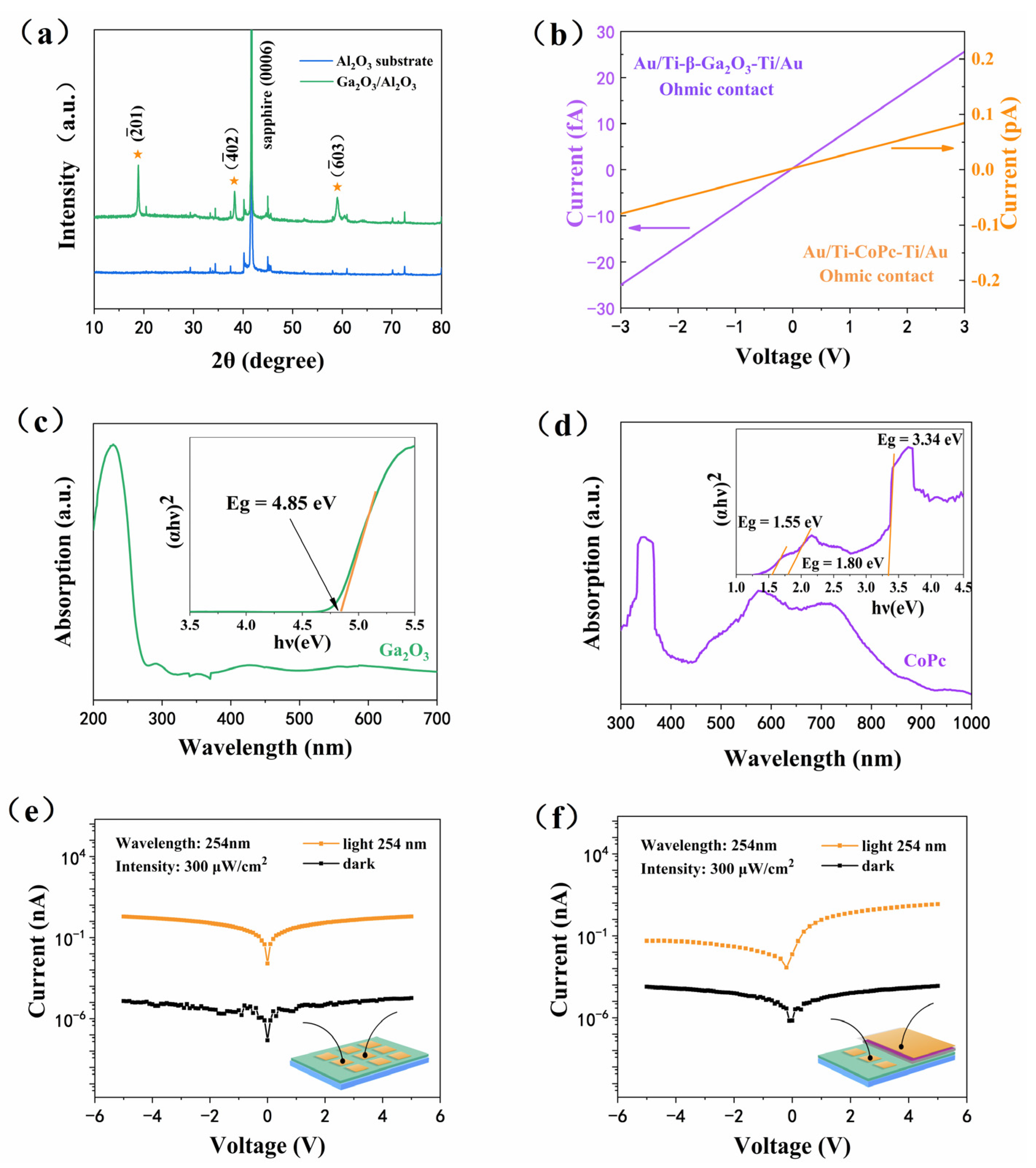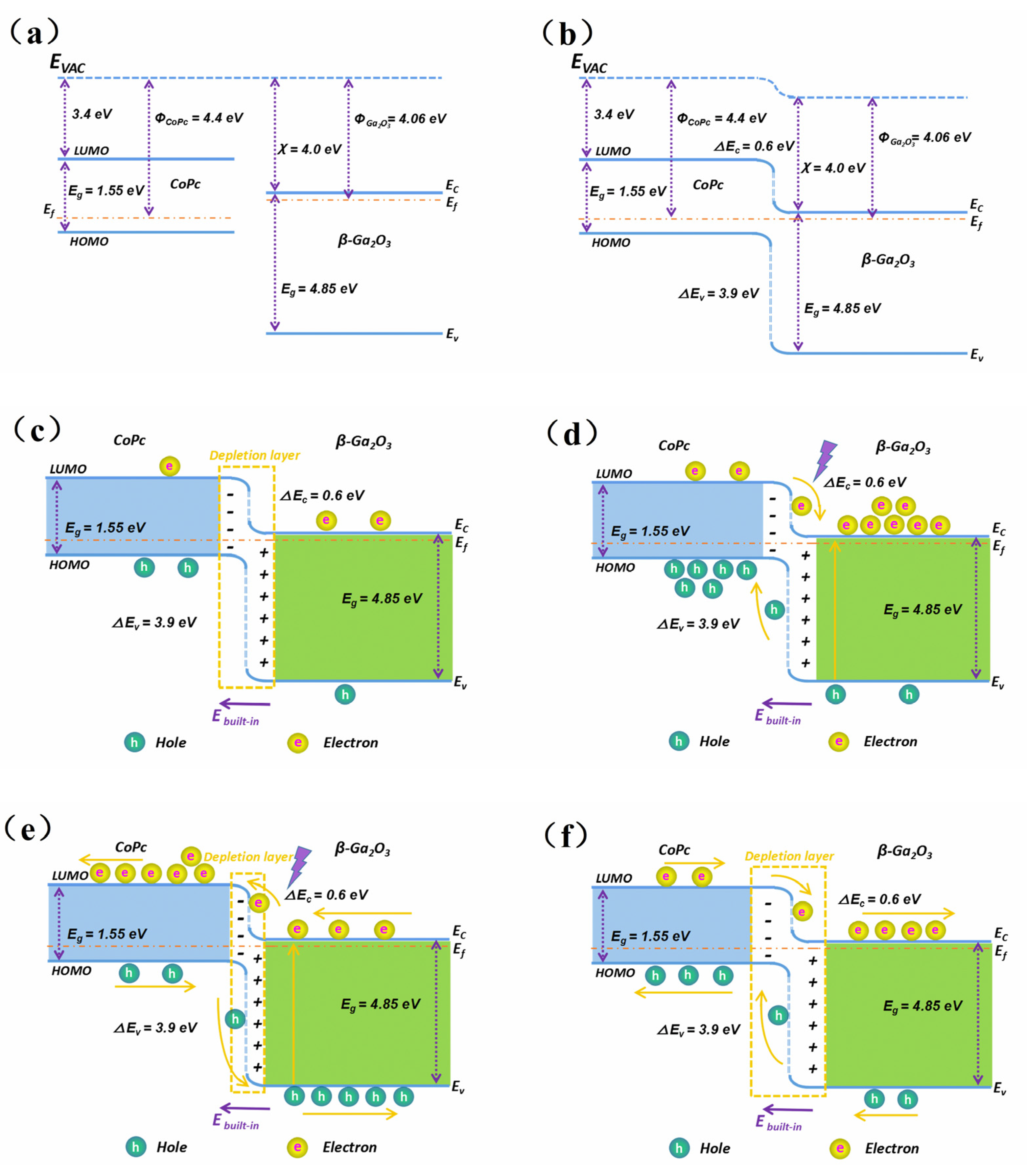A Deep-Ultraviolet Photodetector of a Hybrid Organic-Inorganic p-CoPc/n-Ga2O3 Heterostructure Highlighting Ultra-Sensitive
Abstract
:1. Introduction
2. Experimental
2.1. Syntheses of CoPc Precursor Solution
2.2. Syntheses of β-Ga2O3
2.3. Fabrication of β-Ga2O3/CoPc Heterojunction Device
2.4. Characterization
3. Results and Discussion
4. Conclusions
Author Contributions
Funding
Data Availability Statement
Conflicts of Interest
References
- Tsao, J.Y.; Chowdhury, S.; Hollis, M.A.; Jena, D.; Johnson, N.M.; Jones, K.A.; Kaplar, R.J.; Rajan, S.; Van de Walle, C.G.; Bellotti, E.; et al. Ultrawide-Bandgap Semiconductors: Research Opportunities and Challenges. Adv. Electron. Mater. 2017, 4, 1600501. [Google Scholar] [CrossRef]
- Zheng, W.; Huang, F.; Zheng, R.; Wu, H. Low-Dimensional Structure Vacuum-Ultraviolet-Sensitive (λ <200 nm) Photodetector with Fast-Response Speed Based on High-Quality AlN Micro/Nanowire. Adv. Mater. 2015, 27, 3921–3927. [Google Scholar] [CrossRef] [PubMed]
- Zhang, Q.; Li, X.; He, Z.; Xu, M.; Jin, C.; Zhou, X. 2D semiconductors towards high-performance ultraviolet photodetection. J. Phys. D Appl. Phys. 2019, 52, 303002. [Google Scholar] [CrossRef]
- Xie, C.; Lu, X.-T.; Tong, X.-W.; Zhang, Z.-X.; Liang, F.-X.; Liang, L.; Luo, L.-B.; Wu, Y.-C. Recent Progress in Solar-Blind Deep-Ultraviolet Photodetectors Based on Inorganic Ultrawide Bandgap Semiconductors. Adv. Funct. Mater. 2019, 29, 1806006. [Google Scholar] [CrossRef]
- Zhou, C.; Ai, Q.; Chen, X.; Gao, X.; Liu, K.; Shen, D. Ultraviolet photodetectors based on wide bandgap oxide semiconductor films. Chin. Phys. B 2019, 28, 048503. [Google Scholar] [CrossRef]
- Chen, X.; Ren, F.-F.; Ye, J.; Gu, S. Gallium oxide-based solar-blind ultraviolet photodetectors. Semicond. Sci. Technol. 2020, 35, 023001. [Google Scholar] [CrossRef]
- Liu, Z.; Yu, J.; Li, P.; Wang, X.; Zhi, Y.; Chu, X.; Wang, X.; Li, H.; Wu, Z.; Tang, W. Band alignments of β-Ga2O3 with MgO, Al2O3 and MgAl2O4 measured by x-ray photoelectron spectroscopy. J. Phys. D Appl. Phys. 2019, 52, 295104. [Google Scholar] [CrossRef]
- Xu, J.; Zheng, W.; Huang, F. Gallium oxide solar-blind ultraviolet photodetectors: A review. J. Mater. Chem. C 2019, 7, 8753–8770. [Google Scholar] [CrossRef]
- Kaur, D.; Kumar, M. A Strategic Review on Gallium Oxide Based Deep-Ultraviolet Photodetectors: Recent Progress and Future Prospects. Adv. Opt. Mater. 2021, 9, 2002160. [Google Scholar] [CrossRef]
- Baldini, M.; Galazka, Z.; Wagner, G. Recent progress in the growth of β-Ga2O3 for power electronics applications. Mater. Sci. Semicond. Process. 2018, 78, 132–146. [Google Scholar] [CrossRef]
- Chen, M.; Zhao, B.; Hu, G.; Fang, X.; Wang, H.; Wang, L.; Luo, J.; Han, X.; Wang, X.; Pan, C.; et al. Piezo-Phototronic Effect Modulated Deep UV Photodetector Based on ZnO-Ga2O3 Heterojuction Microwire. Adv. Funct. Mater. 2018, 28, 1706379. [Google Scholar] [CrossRef]
- Bae, H.; Charnas, A.; Sun, X.; Noh, J.; Si, M.; Chung, W.; Qiu, G.; Lyu, X.; Alghamdi, S.; Wang, H.; et al. Solar-Blind UV Photodetector Based on Atomic Layer-Deposited Cu2O and Nanomembrane beta-Ga2O3 pn Oxide Heterojunction. ACS Omega 2019, 4, 20756–20761. [Google Scholar] [CrossRef] [PubMed]
- Ding, W.; Meng, X. High performance solar-blind UV detector based on β-Ga2O3/GaN nanowires heterojunction. J. Alloys Compd. 2021, 866, 157564. [Google Scholar] [CrossRef]
- Li, S.; Yan, Z.; Liu, Z.; Chen, J.; Zhi, Y.; Guo, D.; Li, P.; Wu, Z.; Tang, W. A self-powered solar-blind photodetector with largeVocenhancing performance based on the PEDOT:PSS/Ga2O3organic–inorganic hybrid heterojunction. J. Mater. Chem. C 2020, 8, 1292–1300. [Google Scholar] [CrossRef]
- Kumar, A.; Prasad, R.; Debnath, A.K.; Singh, A.; Samanta, S.; Aswal, D.K.; Gupta, S.K. Growth and Electrical Transport Properties of Organic Semiconductor Thin Films. Solid State Phenom. 2013, 209, 1–5. [Google Scholar] [CrossRef]
- Ma, Z.; Zhao, J.; Wang, X.; Yu, J. Effect of bulk and planar heterojunctions based charge generation layers on the performance of tandem organic light-emitting diodes. Org. Electron. 2016, 30, 136–142. [Google Scholar] [CrossRef]
- Wahab, F.; Sayyad, M.H.; Nawaz Khan, D.; Tahir, M.; Aziz, F.; Shahid, M.; Ali Munawar, M.; Anwar Chaudry, J. Electrical characterization of cobalt phthalocyanine/p-silicon heterojunction. Mater. Sci. Semicond. Process. 2014, 26, 101–106. [Google Scholar] [CrossRef]
- Bilgiçli, A.T.; Yaraşır, M.N.; Kandaz, M.; İlik, C.; Demir, A.; Bağcı, S. Nonperipheral tetra phthalocyanines bearing alkyl chain moiety; Synthesis, characterization and fabrication of the OFET based on phthalocyanine. Synth. Met. 2015, 206, 33–41. [Google Scholar] [CrossRef]
- Jetly, A.; Mehra, R. Efficient Tandem Organic Light Emitting Diode Using Organic Photovoltaic Charge Generation Layer. Int. J. Opt. 2018, 2018, 9458530. [Google Scholar] [CrossRef]
- Wahab, F.; Sayyad, M.H.; Khan, D.N.; Tahir, M.; Aziz, F.; Khan, R.; Karimov, K.S. Sensing Properties of Cobalt-Phthalocyanine-Based Multipurpose Sensor. J. Electron. Mater. 2016, 46, 2045–2052. [Google Scholar] [CrossRef]
- Xiao, Y.; Liu, L.; Ma, Z.H.; Meng, B.; Qin, S.J.; Pan, G.B. High-Performance Self-Powered Ultraviolet Photodetector Based on Nano-Porous GaN and CoPc p-n Vertical Heterojunction. Nanomaterials 2019, 9, 1198. [Google Scholar] [CrossRef] [PubMed]
- Liu, Z.; Li, S.; Yan, Z.; Liu, Y.; Zhi, Y.; Wang, X.; Wu, Z.; Li, P.; Tang, W. Construction of a β-Ga2O3-based metal–oxide–semiconductor-structured photodiode for high-performance dual-mode solar-blind detector applications. J. Mater. Chem. C 2020, 8, 5071–5081. [Google Scholar] [CrossRef]
- Seoudi, R.; El-Bahy, G.S.; El Sayed, Z.A. Ultraviolet and visible spectroscopic studies of phthalocyanine and its complexes thin films. Opt. Mater. 2006, 29, 304–312. [Google Scholar] [CrossRef]
- Liu, G.; Wang, Y.; Zhou, Y.; Cao, J.; Yuan, M.; Lv, H. Phosphorous doped g-C3N4 supported cobalt phthalocyanine: An efficient photocatalyst for reduction of CO2 under visible-light irradiation. J. Colloid Interface Sci. 2021, 594, 658–668. [Google Scholar] [CrossRef] [PubMed]
- Ma, G.-L.; Gao, A.; Liu, Z.; Sun, W.-M.; Li, S.; Yan, Z.-Y.; Jiang, W.-Y.; Sun, B.-Y.; Qi, X.-H.; Li, P.-G.; et al. Solution Spin-Coated BiFeO3 Onto Ga2O3 Towards Self-Powered Deep UV Photo Detector of Ga2O3/BiFeO3 Heterojunction. IEEE Sens. J. 2021, 21, 23987–23994. [Google Scholar] [CrossRef]
- Dai, J.; Li, S.; Liu, Z.; Yan, Z.; Zhi, Y.; Wu, Z.; Li, P.; Tang, W. Fabrication of a poly(N-vinyl carbazole)/ϵ-Ga2O3 organic–inorganic heterojunction diode for solar-blind sensing applications. J. Phys. D Appl. Phys. 2021, 54, 215104. [Google Scholar] [CrossRef]
- Li, S.; Guo, D.; Li, P.; Wang, X.; Wang, Y.; Yan, Z.; Liu, Z.; Zhi, Y.; Huang, Y.; Wu, Z.; et al. Ultrasensitive, Superhigh Signal-to-Noise Ratio, Self-Powered Solar-Blind Photodetector Based on n-Ga2O3/p-CuSCN Core-Shell Microwire Heterojunction. ACS Appl. Mater. Interfaces 2019, 11, 35105–35114. [Google Scholar] [CrossRef]
- Yan, Z.; Li, S.; Liu, Z.; Zhi, Y.; Dai, J.; Sun, X.; Sun, S.; Guo, D.; Wang, X.; Li, P.; et al. High sensitivity and fast response self-powered solar-blind ultraviolet photodetector with a β-Ga2O3/spiro-MeOTAD p–n heterojunction. J. Mater. Chem. C 2020, 8, 4502–4509. [Google Scholar] [CrossRef]
- Gao, A.; Jiang, W.; Ma, G.; Liu, Z.; Li, S.; Yan, Z.; Sun, W.; Zhang, S.; Tang, W. A self-powered β-Ga2O3/CsCu2I3 heterojunction photodiode responding to deep ultraviolet irradiation. Curr. Appl. Phys. 2022, 33, 20–26. [Google Scholar] [CrossRef]
- Kokubun, Y.; Kubo, S.; Nakagomi, S. All-oxide p–n heterojunction diodes comprising p-type NiO and n-type β-Ga2O3. Appl. Phys. Express 2016, 9, 091101. [Google Scholar] [CrossRef]
- Fatima, N.; Ahmed, M.M.; Karimov, K.S.; Ahmad, Z.; Muhammad, F.F. Optical sensors based on the NiPc–CoPc composite films deposited by drop casting and under the action of centrifugal force. Chin. Phys. B 2017, 26, 060704. [Google Scholar] [CrossRef]
- Klein, A. Energy band alignment at interfaces of semiconducting oxides: A review of experimental determination using photoelectron spectroscopy and comparison with theoretical predictions by the electron affinity rule, charge neutrality levels, and the common anion rule. Thin Solid Films 2012, 520, 3721–3728. [Google Scholar] [CrossRef]
- Wang, Y.; Tang, Y.; Li, H.; Yang, Z.; Zhang, Q.; He, Z.; Huang, X.; Wei, X.; Tang, W.; Huang, W.; et al. p-GaSe/n-Ga2O3 van der Waals Heterostructure Photodetector at Solar-Blind Wavelengths with Ultrahigh Responsivity and Detectivity. ACS Photonics 2021, 8, 2256–2264. [Google Scholar] [CrossRef]
- Li, P.; Shi, H.; Chen, K.; Guo, D.; Cui, W.; Zhi, Y.; Wang, S.; Wu, Z.; Chen, Z.; Tang, W. Construction of GaN/Ga2O3 p–n junction for an extremely high responsivity self-powered UV photodetector. J. Mater. Chem. C 2017, 5, 10562–10570. [Google Scholar] [CrossRef]






Publisher’s Note: MDPI stays neutral with regard to jurisdictional claims in published maps and institutional affiliations. |
© 2022 by the authors. Licensee MDPI, Basel, Switzerland. This article is an open access article distributed under the terms and conditions of the Creative Commons Attribution (CC BY) license (https://creativecommons.org/licenses/by/4.0/).
Share and Cite
Qi, X.; Ji, X.; Yue, J.; Qi, S.; Wang, J.; Li, P.; Tang, W. A Deep-Ultraviolet Photodetector of a Hybrid Organic-Inorganic p-CoPc/n-Ga2O3 Heterostructure Highlighting Ultra-Sensitive. Crystals 2022, 12, 1284. https://doi.org/10.3390/cryst12091284
Qi X, Ji X, Yue J, Qi S, Wang J, Li P, Tang W. A Deep-Ultraviolet Photodetector of a Hybrid Organic-Inorganic p-CoPc/n-Ga2O3 Heterostructure Highlighting Ultra-Sensitive. Crystals. 2022; 12(9):1284. https://doi.org/10.3390/cryst12091284
Chicago/Turabian StyleQi, Xiaohui, Xueqiang Ji, Jianying Yue, Song Qi, Jinjin Wang, Peigang Li, and Weihua Tang. 2022. "A Deep-Ultraviolet Photodetector of a Hybrid Organic-Inorganic p-CoPc/n-Ga2O3 Heterostructure Highlighting Ultra-Sensitive" Crystals 12, no. 9: 1284. https://doi.org/10.3390/cryst12091284
APA StyleQi, X., Ji, X., Yue, J., Qi, S., Wang, J., Li, P., & Tang, W. (2022). A Deep-Ultraviolet Photodetector of a Hybrid Organic-Inorganic p-CoPc/n-Ga2O3 Heterostructure Highlighting Ultra-Sensitive. Crystals, 12(9), 1284. https://doi.org/10.3390/cryst12091284







